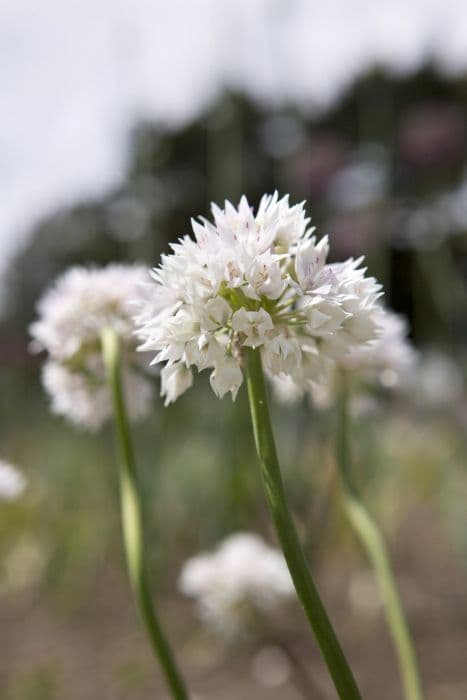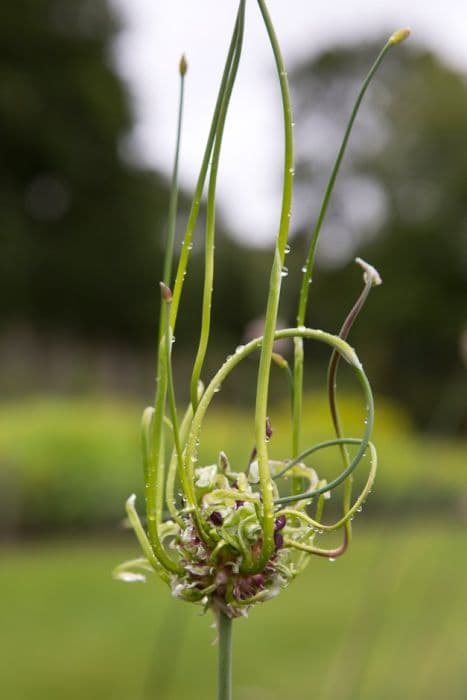Ornamental onion Allium 'Eros'

ABOUT
The Allium 'Eros' is best known for its showy, spherical flower heads that consist of numerous small, star-shaped flowers tightly clustered together. These blooms can vary in color from pink to purple, creating a vibrant and striking display. Emerging atop sturdy stems, the flowers make a bold statement in the garden with their dense, almost pom-pom-like appearance. The foliage of 'Eros' is typically a fresh green color, comprising long, slender leaves that often have a glossy texture. The leaves tend to have a classic onion-like appearance, given the plant's relation to the edible onion, with a distinct smell that can be noticeable when the foliage is crushed or bruised. Overall, the combination of its spherical flower clusters and graceful foliage provides a unique visual interest and texture to gardens and floral arrangements.
About this plant
 Names
NamesFamily
Amaryllidaceae
Synonyms
Eros Allium, Eros Onion, Ornamental Onion
Common names
Allium 'Eros'.
 Toxicity
ToxicityTo humans
The Allium 'Eros', commonly known as the ornamental onion, typically poses minimal toxicity to humans. If ingested in large quantities, it could cause mild stomach discomfort or irritation. However, symptoms of poisoning from this plant are generally not severe for humans.
To pets
The ornamental onion is highly toxic to pets, especially cats and dogs. Ingesting any part of the plant can lead to symptoms such as vomiting, diarrhea, abdominal pain, and in severe cases, it can cause anemia or red blood cells damage due to the presence of compounds called thiosulphates. Immediate veterinary attention is recommended if a pet has consumed any part of this plant.
 Characteristics
CharacteristicsLife cycle
Perennials
Foliage type
Deciduous
Color of leaves
Green
Flower color
Pink
Height
1-2 feet (30-60 cm)
Spread
1-2 feet (30-60 cm)
Plant type
Bulb
Hardiness zones
4-8
Native area
Asia
Benefits
 General Benefits
General Benefits- Ornamental Appeal: The Allium 'Eros' features attractive, ball-shaped blooms that add visual interest to gardens and landscapes.
- Drought Tolerance: This plant is well-suited to tolerate dry conditions once established, making it a good choice for water-wise gardening.
- Low Maintenance: It requires minimal care once planted, making it ideal for gardeners looking for low-maintenance options.
- Pest Resistance: The allium family is known for being resistant to many common garden pests, reducing the need for chemical interventions.
- Attracts Pollinators: Allium 'Eros' flowers are attractive to bees, butterflies, and other pollinating insects, supporting biodiversity.
- Deer and Rodent Resistant: The plant is typically not favored by deer and rodents, which can help to protect other more vulnerable plants in the garden.
- Long Blooming: 'Eros' has a long flowering period, which can help to ensure continuous color in the garden throughout the season.
- Easy to Grow: Allium 'Eros' can be easily grown in a variety of soil types, as long as there is good drainage.
- Culinary Use: While not a primary benefit of Allium 'Eros', some allium species are used in cooking and this plant can add an aesthetic quality to kitchen gardens.
 Medical Properties
Medical PropertiesThis plant is not used for medical purposes.
 Air-purifying Qualities
Air-purifying QualitiesThis plant is not specifically known for air purifying qualities.
 Other Uses
Other Uses- Photography Prop: The Allium 'Eros', with its small, round pinkish-purple flowers, can be used by photographers for macro photography or as an aesthetic backdrop for portraits.
- Boutonnieres: Small flower heads of Allium 'Eros' can be used in boutonnieres for weddings and proms for a unique and elegant touch.
- Dye Production: The pigments from the 'Eros' flowers may be used in natural dyeing processes, adding a subtle color to textiles.
- Culinary Garnish: The flowers can be used as an edible garnish on salads and desserts for a splash of color and a mild onion flavor.
- Floral Arrangements: Due to its distinctive spherical shape and color, Allium 'Eros' is a popular choice among florists for creating interesting and dynamic floral arrangements.
- Garden Borders: These plants can be used to create defining lines along garden borders due to their height and structure.
- Art Subjects: Allium 'Eros' can be an inspiration for artists, serving as a subject for painting, drawing, or even sculpting.
- Decorative Dried Flowers: Even after blooming, dried Allium 'Eros' flowers can be used for decorative purposes such as in wreaths or dried flower arrangements.
- Fairy Gardens: The whimsical nature of the Allium 'Eros' makes it a fitting addition to miniature fairy gardens and fantasy landscapes.
- Insect Attraction: These plants can be strategically placed in gardens to attract pollinators like bees, butterflies, and other beneficial insects.
Interesting Facts
 Feng Shui
Feng ShuiOrnamental onion is not used in Feng Shui practice.
 Zodiac Sign Compitability
Zodiac Sign CompitabilityOrnamental onion is not used in astrology practice.
 Plant Symbolism
Plant Symbolism- Love and Attraction: The 'Eros' part of Allium 'Eros' alludes to the Greek god of love and desire, symbolizing the plant's connection with passion and the power to attract and charm others.
- Strength and Courage: Alliums in general are admired for their sturdy and upright stems, representing resilience, and the determination to stand strong in the face of adversity.
- Unity and Humility: With its globe-shaped cluster of flowers, Allium 'Eros' can symbolize community and the idea that many parts make a whole, emphasizing the value of togetherness and modesty.
- Good Fortune: In some cultures, alliums are believed to bring luck and are often planted to ward off evil spirits, suggesting that Allium 'Eros' may carry with it wishes for good fortune.
- Perseverance: Given their ability to thrive in a variety of conditions, alliums, including Allium 'Eros', may also represent the ability to persevere and succeed regardless of circumstances.
 Water
WaterThe ornamental onion should be watered thoroughly once a week, providing approximately 1 inch of water each time. It's important to allow the soil to dry out somewhat between waterings, as overwatering can lead to bulb rot. When you do water, do so at the base of the plant to avoid wetting the foliage, which can promote fungal diseases. During periods of drought, you may need to water twice a week, while in cooler, wetter periods, watering can be reduced. Always check the soil moisture level to gauge if additional water is needed.
 Light
LightThe ornamental onion thrives best in full sun conditions, receiving at least 6 to 8 hours of direct sunlight per day. A spot in the garden that provides morning sunlight and some afternoon shade can also be suitable, as long as the light is bright. Avoid deeply shaded areas as this can impede the plant's growth and flowering potential.
 Temperature
TemperatureThe ornamental onion prefers temperate climates and can generally handle temperatures down to about 20°F before going dormant. The ideal growing temperature range is between 55°F and 75°F. While the plant is hardy and can survive light frosts, it's best to protect it from extreme cold snaps by providing mulch or other forms of insulation.
 Pruning
PruningOrnamental onions benefit from pruning primarily to remove spent flower heads; this encourages the plant to focus its energy on robust bulb growth rather than seed production. Deadheading can be done once the flowers begin to fade. Additionally, you may prune any yellowing or withered leaves in late summer or fall. Pruning is not required frequently, mainly after blooming and before dormancy. The best time for pruning is late summer to early fall.
 Cleaning
CleaningAs needed
 Soil
SoilOrnamental onion 'Eros' thrives in well-draining soil with a blend of loam, sand, and compost. The ideal pH for this plant is between 6.0 and 7.0 to ensure proper nutrient uptake and growth.
 Repotting
RepottingOrnamental onion 'Eros' should be repotted every 2-3 years or when it becomes root-bound. Monitoring for crowded conditions can help determine the best time to repot.
 Humidity & Misting
Humidity & MistingOrnamental onion 'Eros' prefers moderate humidity levels but is adaptable to average home humidity. It does not require any special humidity considerations.
 Suitable locations
Suitable locationsIndoor
Use bright indirect light, well-draining soil, and a pot with drainage.
Outdoor
Plant in full sun to partial shade, in well-draining soil.
Hardiness zone
4-8 USDA
 Life cycle
Life cycleAllium 'Eros', commonly known as Ornamental Onion, begins its life cycle when a seed germinates in fertile, well-drained soil, typically in late winter or early spring. Upon sprouting, the seedling develops roots and foliage, growing into a small bulb that gathers energy through its leaves. The plant enters a vegetative state throughout the spring and summer, storing nutrients in the bulb for the next cycle. In late spring or early summer, Allium 'Eros' produces a tall stem topped with a spherical cluster of star-shaped flowers, which attract pollinators and may lead to seed production if fertilized. After flowering, the plant enters a dormant period in late summer or early fall, with the foliage dying back and the bulb resting underground. The cycle resumes the following spring when new growth emerges from the bulb, repeating the annual growth and dormancy pattern.
 Propogation
PropogationPropogation time
Spring to summer
Propogation: The Allium 'Eros', commonly known as ornamental onion, is best propagated through division, typically in early spring or autumn when the plant is dormant. To propagate by division, carefully dig up the clump of bulbs and gently separate them, making sure each division has at least one or two bulbs. Replant the divisions immediately at the same depth they were growing before, spacing them about 6 to 8 inches (approximately 15 to 20 centimeters) apart to allow room for growth. Water the newly planted divisions thoroughly to establish their root systems. Division helps to rejuvenate the plants and prevent overcrowding, which can diminish blooming.








